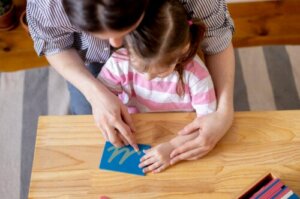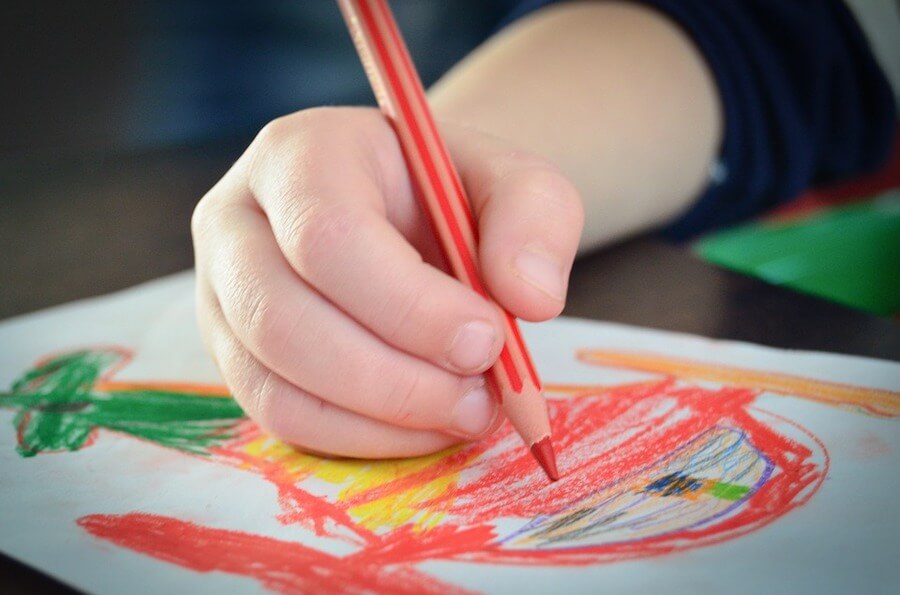Top 10 Graphomotor Skill Exercises for Learning to Write

In the stages prior to the acquisition of writing, we can stimulate children with graphomotor skill activities and exercises. All of these activities can work for different purposes, but they’ll also give them the necessary skills to learn to write.
From birth, children progress with fine motor development, and with your encouragement, through games and practical activities at home, you can help them to enhance their achievements.
You don’t have to wait until they reach elementary school to encourage this learning, as the foundations are laid much earlier than you think.
“Graphomotor skills are based on the graphic units that make up the infant language code (ILC), called graphemes, which appear in the spontaneous productions of children from 18-24 months of age.
-Maria Dolores Rius Estrada.
So, once your child sits down, performs the pincer grasp movement with their fingers, and coordinates hand movements with their gaze, they’ll be ready to execute these graphomotor skill exercises. Shall we begin?
Graphomotor skill exercises to do at home
We’ve organized the following activities in order of increasing difficulty, that is, from the least to the most complex. However, they’re all very useful for children to exercise their fingers and hands and thus stimulate graphomotor skills. Take note!
1. Singing, dancing, and accompanying the rhythm of music with your hands
Keeping the rhythm with your palms is a great exercise to enhance the dexterity of the hands. The idea is to use simple songs to teach children how to follow the beat of the music. And if you also incorporate body movements with dances and rounds, your children will have a great time laughing!

2. Imitate actions with hand movements
This activity can be put into practice with different daily actions that involve manual movements that little ones can imitate. For example, eating, washing hair, sweeping, riding a bicycle, folding clothes, washing your face, among others.
3. Representing animals with their hands
The exercise consists of children choosing their favorite animal and trying to imitate its movements with their hands: The movement of an elephant’s trunk, the flapping of a bird’s wings, the flight of a butterfly, the claws of a bear, etc.
4. Hand painting: Another sensory graphomotor skill exercise
Let’s get messy and have fun! This is one of the best tasks to stimulate the dexterity of the hands, as it sets all their parts in motion while activating a sensory component: Touch.
5. Practice graphomotor exercises to improve finger dexterity
Playing games with the fingers, such as joining and separating them, first one by one and then in pairs, helps to exercise the coordination of hand movements with brain activity. It’s also fun to teach little ones some gestures such as crossing fingers for luck or raising the thumb as a sign of approval.
6. Playing cards
Shuffling cards and dealing them out is a good exercise to promote hand and finger dexterity. If you add counting, you have a very complete learning experience!
7. Exercise with the game of “rock, paper, scissors”
This is a traditional game for children that’s great for stimulating hand and finger coordination, which is so important for graphomotor skills.

8. Drawing dots, lines, and dashes
With little ones, you can start to draw with dots and dashes, and as they progress, the next step is to draw straight lines. An interesting way to learn is to go over the lines on a sheet of graph paper or make stripes in different directions.
9. Graphing curved lines and rounded shapes
This skill is already a bit more complex, as it requires a lot of finger control to make curved shapes, such as circles, spirals, waves, loops, or rainbows and clouds.
This exercise is special, because it helps a lot in the learning of cursive writing, as most letters have curved or rounded shapes.
10. Exercise with more advanced graphomotor skill activities: Coloring in the lines
Painting inside the edges of a stencil or drawing is a complex, but very effective exercise. It requires concentration, complete control of hand and finger movements, and a great deal of patience.

What are the benefits of graphomotor skill exercises for learning to write?
Learning to write is an important milestone in children’s lives, but before this, the skills of the pre-writing stage must be well mastered.
According to the natural physical development and the ability to perform certain movements with the hands and body, children begin to thicken their fine motor skills with drawings of dots, lines, and scribbles.
As they get older, the tasks become more complex. At this point, it’s important that you stimulate your child with games and graphomotor exercises like the ones we proposed today. The benefits of doing so are the following:
- It’s easier to learn to write
- Better performance in learning to read and write
- Increased concentration time and attention to tasks
- The stimulation of creativity and expressiveness through graphic forms
Stimulate graphomotor skills using enjoyment and fun
With these types of activities, we want you to see how many things you can do as a family to accompany children in their development. The most important thing is not to skip stages and respect their time so that they can learn from a place of enjoyment and at a natural pace.
In the stages prior to the acquisition of writing, we can stimulate children with graphomotor skill activities and exercises. All of these activities can work for different purposes, but they’ll also give them the necessary skills to learn to write.
From birth, children progress with fine motor development, and with your encouragement, through games and practical activities at home, you can help them to enhance their achievements.
You don’t have to wait until they reach elementary school to encourage this learning, as the foundations are laid much earlier than you think.
“Graphomotor skills are based on the graphic units that make up the infant language code (ILC), called graphemes, which appear in the spontaneous productions of children from 18-24 months of age.
-Maria Dolores Rius Estrada.
So, once your child sits down, performs the pincer grasp movement with their fingers, and coordinates hand movements with their gaze, they’ll be ready to execute these graphomotor skill exercises. Shall we begin?
Graphomotor skill exercises to do at home
We’ve organized the following activities in order of increasing difficulty, that is, from the least to the most complex. However, they’re all very useful for children to exercise their fingers and hands and thus stimulate graphomotor skills. Take note!
1. Singing, dancing, and accompanying the rhythm of music with your hands
Keeping the rhythm with your palms is a great exercise to enhance the dexterity of the hands. The idea is to use simple songs to teach children how to follow the beat of the music. And if you also incorporate body movements with dances and rounds, your children will have a great time laughing!

2. Imitate actions with hand movements
This activity can be put into practice with different daily actions that involve manual movements that little ones can imitate. For example, eating, washing hair, sweeping, riding a bicycle, folding clothes, washing your face, among others.
3. Representing animals with their hands
The exercise consists of children choosing their favorite animal and trying to imitate its movements with their hands: The movement of an elephant’s trunk, the flapping of a bird’s wings, the flight of a butterfly, the claws of a bear, etc.
4. Hand painting: Another sensory graphomotor skill exercise
Let’s get messy and have fun! This is one of the best tasks to stimulate the dexterity of the hands, as it sets all their parts in motion while activating a sensory component: Touch.
5. Practice graphomotor exercises to improve finger dexterity
Playing games with the fingers, such as joining and separating them, first one by one and then in pairs, helps to exercise the coordination of hand movements with brain activity. It’s also fun to teach little ones some gestures such as crossing fingers for luck or raising the thumb as a sign of approval.
6. Playing cards
Shuffling cards and dealing them out is a good exercise to promote hand and finger dexterity. If you add counting, you have a very complete learning experience!
7. Exercise with the game of “rock, paper, scissors”
This is a traditional game for children that’s great for stimulating hand and finger coordination, which is so important for graphomotor skills.

8. Drawing dots, lines, and dashes
With little ones, you can start to draw with dots and dashes, and as they progress, the next step is to draw straight lines. An interesting way to learn is to go over the lines on a sheet of graph paper or make stripes in different directions.
9. Graphing curved lines and rounded shapes
This skill is already a bit more complex, as it requires a lot of finger control to make curved shapes, such as circles, spirals, waves, loops, or rainbows and clouds.
This exercise is special, because it helps a lot in the learning of cursive writing, as most letters have curved or rounded shapes.
10. Exercise with more advanced graphomotor skill activities: Coloring in the lines
Painting inside the edges of a stencil or drawing is a complex, but very effective exercise. It requires concentration, complete control of hand and finger movements, and a great deal of patience.

What are the benefits of graphomotor skill exercises for learning to write?
Learning to write is an important milestone in children’s lives, but before this, the skills of the pre-writing stage must be well mastered.
According to the natural physical development and the ability to perform certain movements with the hands and body, children begin to thicken their fine motor skills with drawings of dots, lines, and scribbles.
As they get older, the tasks become more complex. At this point, it’s important that you stimulate your child with games and graphomotor exercises like the ones we proposed today. The benefits of doing so are the following:
- It’s easier to learn to write
- Better performance in learning to read and write
- Increased concentration time and attention to tasks
- The stimulation of creativity and expressiveness through graphic forms
Stimulate graphomotor skills using enjoyment and fun
With these types of activities, we want you to see how many things you can do as a family to accompany children in their development. The most important thing is not to skip stages and respect their time so that they can learn from a place of enjoyment and at a natural pace.
All cited sources were thoroughly reviewed by our team to ensure their quality, reliability, currency, and validity. The bibliography of this article was considered reliable and of academic or scientific accuracy.
- Cabrera Valdes, B. Buyperon Garcia, M. (2019). El desarrollo de la motricidad fina en los niños y niñas del grado preescolar. Revista de Educación Mendive. Disponible en: http://scielo.sld.cu/scielo.php?script=sci_arttext&pid=S1815-76962019000200222
- Maquera-Maquera. Y., Bermejo-Paredes,S., Olivera-Condori,E., Vilca-Apaza,H. (2020). Intervención familia-aula para el desarrollo de habilidades grafomotrices. Revista de Educación Alteridad. Revista de Educación, vol. 16, núm. 1. Universidad Politécnica Salesiana, Perú. Disponible en: https://www.redalyc.org/journal/4677/467765130007/html/
- Rius Estrada, M. (2003) Educación de la grafomotricidad: un proceso natural. Enciclopedia de Educación Infantl, Málaga, España. Disponible en: https://docplayer.es/14527576-Educacion-de-la-grafomotricidad-un-proceso-natural.html
This text is provided for informational purposes only and does not replace consultation with a professional. If in doubt, consult your specialist.








